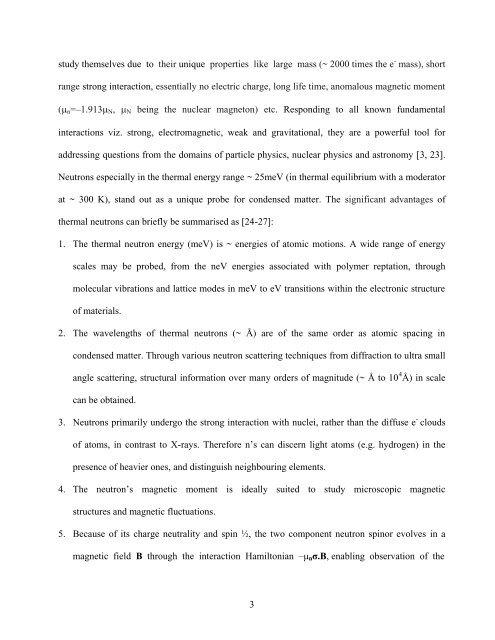PHYS01200804001 Sohrab Abbas - Homi Bhabha National Institute
PHYS01200804001 Sohrab Abbas - Homi Bhabha National Institute
PHYS01200804001 Sohrab Abbas - Homi Bhabha National Institute
You also want an ePaper? Increase the reach of your titles
YUMPU automatically turns print PDFs into web optimized ePapers that Google loves.
study themselves due to their unique properties like large mass (~ 2000 times the e - mass), short<br />
range strong interaction, essentially no electric charge, long life time, anomalous magnetic moment<br />
( n =–1.913 N , N being the nuclear magneton) etc. Responding to all known fundamental<br />
interactions viz. strong, electromagnetic, weak and gravitational, they are a powerful tool for<br />
addressing questions from the domains of particle physics, nuclear physics and astronomy [3, 23].<br />
Neutrons especially in the thermal energy range ~ 25meV (in thermal equilibrium with a moderator<br />
at ~ 300 K), stand out as a unique probe for condensed matter. The significant advantages of<br />
thermal neutrons can briefly be summarised as [24-27]:<br />
1. The thermal neutron energy (meV) is ~ energies of atomic motions. A wide range of energy<br />
scales may be probed, from the neV energies associated with polymer reptation, through<br />
molecular vibrations and lattice modes in meV to eV transitions within the electronic structure<br />
of materials.<br />
2. The wavelengths of thermal neutrons (~ Å) are of the same order as atomic spacing in<br />
condensed matter. Through various neutron scattering techniques from diffraction to ultra small<br />
angle scattering, structural information over many orders of magnitude (~ Å to 10 4 Å) in scale<br />
can be obtained.<br />
3. Neutrons primarily undergo the strong interaction with nuclei, rather than the diffuse e - clouds<br />
of atoms, in contrast to X-rays. Therefore n’s can discern light atoms (e.g. hydrogen) in the<br />
presence of heavier ones, and distinguish neighbouring elements.<br />
4. The neutron’s magnetic moment is ideally suited to study microscopic magnetic<br />
structures and magnetic fluctuations.<br />
5. Because of its charge neutrality and spin ½, the two component neutron spinor evolves in a<br />
magnetic field B through the interaction Hamiltonian –μ n σ.B, enabling observation of the<br />
3
















